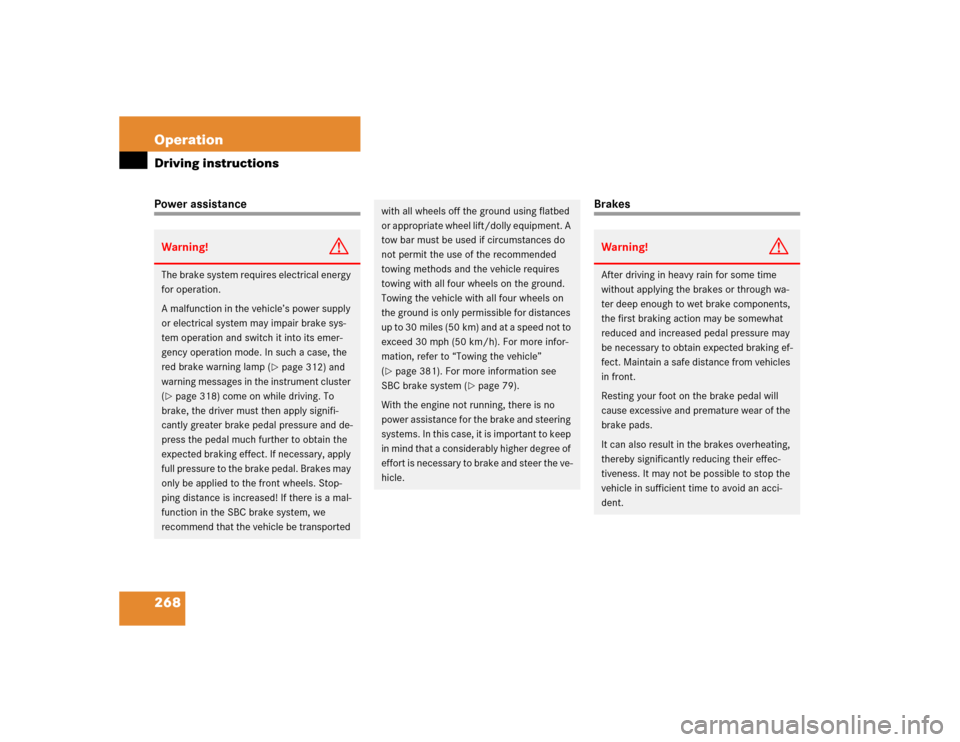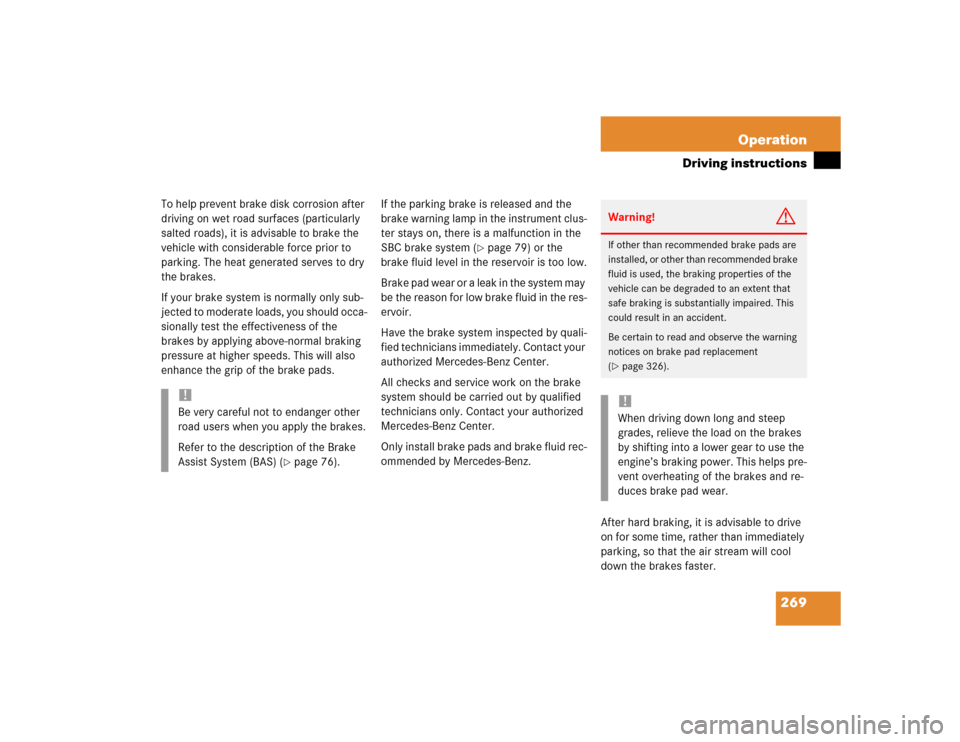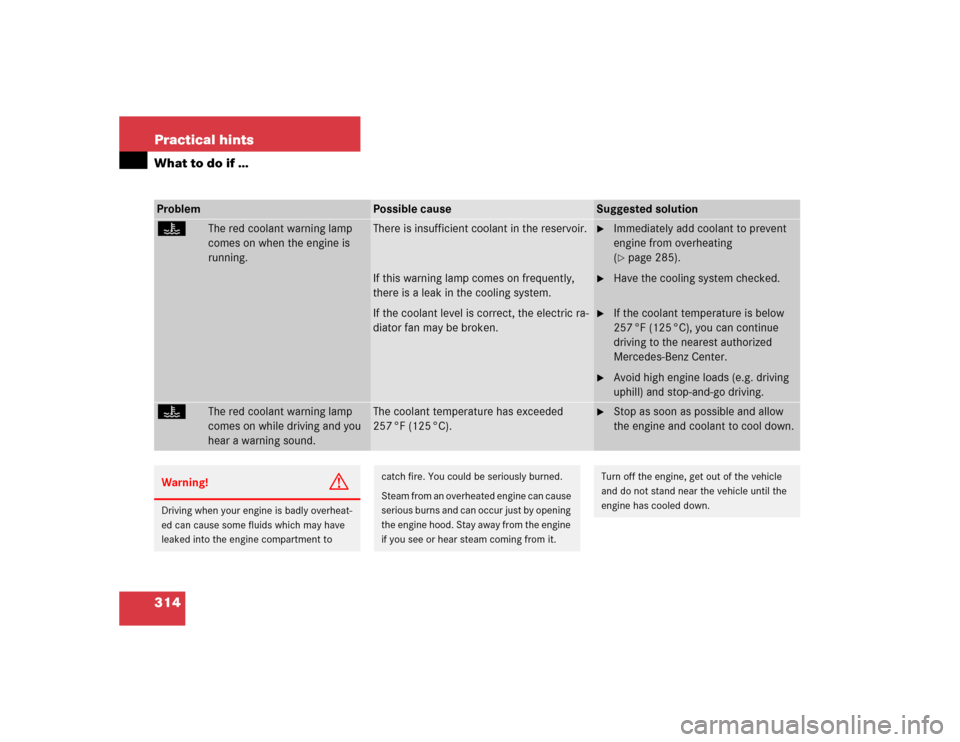Page 268 of 442

268 OperationDriving instructionsPower assistance
Brakes
Warning!
G
The brake system requires electrical energy
for operation.
A malfunction in the vehicle’s power supply
or electrical system may impair brake sys-
tem operation and switch it into its emer-
gency operation mode. In such a case, the
red brake warning lamp (
�page 312) and
warning messages in the instrument cluster
(
�page 318) come on while driving. To
brake, the driver must then apply signifi-
cantly greater brake pedal pressure and de-
press the pedal much further to obtain the
expected braking effect. If necessary, apply
full pressure to the brake pedal. Brakes may
only be applied to the front wheels. Stop-
ping distance is increased! If there is a mal-
function in the SBC brake system, we
recommend that the vehicle be transported
with all wheels off the ground using flatbed
or appropriate wheel lift/dolly equipment. A
tow bar must be used if circumstances do
not permit the use of the recommended
towing methods and the vehicle requires
towing with all four wheels on the ground.
Towing the vehicle with all four wheels on
the ground is only permissible for distances
up to 30 miles (50 km) and at a speed not to
exceed 30 mph (50 km/h). For more infor-
mation, refer to “Towing the vehicle”
(�page 381). For more information see
SBC brake system (
�page 79).
With the engine not running, there is no
power assistance for the brake and steering
systems. In this case, it is important to keep
in mind that a considerably higher degree of
effort is necessary to brake and steer the ve-
hicle.
Warning!
G
After driving in heavy rain for some time
without applying the brakes or through wa-
ter deep enough to wet brake components,
the first braking action may be somewhat
reduced and increased pedal pressure may
be necessary to obtain expected braking ef-
fect. Maintain a safe distance from vehicles
in front.
Resting your foot on the brake pedal will
cause excessive and premature wear of the
brake pads.
It can also result in the brakes overheating,
thereby significantly reducing their effec-
tiveness. It may not be possible to stop the
vehicle in sufficient time to avoid an acci-
dent.
Page 269 of 442

269 Operation
Driving instructions
To help prevent brake disk corrosion after
driving on wet road surfaces (particularly
salted roads), it is advisable to brake the
vehicle with considerable force prior to
parking. The heat generated serves to dry
the brakes.
If your brake system is normally only sub-
j e c t e d t o m o d e r a t e l o a d s , y o u s h o u l d o c c a -
sionally test the effectiveness of the
brakes by applying above-normal braking
pressure at higher speeds. This will also
enhance the grip of the brake pads. If the parking brake is released and the
brake warning lamp in the instrument clus-
ter stays on, there is a malfunction in the
SBC brake system (
�page 79) or the
brake fluid level in the reservoir is too low.
Brake pad wear or a leak in the system may
be the reason for low brake fluid in the res-
ervoir.
Have the brake system inspected by quali-
fied technicians immediately. Contact your
authorized Mercedes-Benz Center.
All checks and service work on the brake
system should be carried out by qualified
technicians only. Contact your authorized
Mercedes-Benz Center.
Only install brake pads and brake fluid rec-
ommended by Mercedes-Benz.
After hard braking, it is advisable to drive
on for some time, rather than immediately
parking, so that the air stream will cool
down the brakes faster.
!Be very careful not to endanger other
road users when you apply the brakes.
Refer to the description of the Brake
Assist System (BAS) (
�page 76).
Warning!
G
If other than recommended brake pads are
installed, or other than recommended brake
fluid is used, the braking properties of the
vehicle can be degraded to an extent that
safe braking is substantially impaired. This
could result in an accident.
Be certain to read and observe the warning
notices on brake pad replacement
(�page 326).!When driving down long and steep
grades, relieve the load on the brakes
by shifting into a lower gear to use the
engine’s braking power. This helps pre-
vent overheating of the brakes and re-
duces brake pad wear.
Page 314 of 442

314 Practical hintsWhat to do if …Problem
Possible cause
Suggested solution
D
The red coolant warning lamp
comes on when the engine is
running.
There is insufficient coolant in the reservoir.
If this warning lamp comes on frequently,
there is a leak in the cooling system.
If the coolant level is correct, the electric ra-
diator fan may be broken.
�
Immediately add coolant to prevent
engine from overheating
(�page 285).
�
Have the cooling system checked.
�
If the coolant temperature is below
257 °F (125 °C), you can continue
driving to the nearest authorized
Mercedes-Benz Center.
�
Avoid high engine loads (e.g. driving
uphill) and stop-and-go driving.
D
The red coolant warning lamp
comes on while driving and you
hear a warning sound.
The coolant temperature has exceeded
257 °F (125 °C).
�
Stop as soon as possible and allow
the engine and coolant to cool down.
Warning!
G
Driving when your engine is badly overheat-
ed can cause some fluids which may have
leaked into the engine compartment to
catch fire. You could be seriously burned.
Steam from an overheated engine can cause
serious burns and can occur just by opening
the engine hood. Stay away from the engine
if you see or hear steam coming from it.
Turn off the engine, get out of the vehicle
and do not stand near the vehicle until the
engine has cooled down.
Page 437 of 442

437 Index
Submenus
Convenience 150
For settings 131
In control system 133
Instrument cluster 141, 143
Lighting 146
Resetting functions in Control
system 139
Selecting 139
Settings menu 139
Vehicle 149
Sun visors 170
Supplemental Restraint System
(SRS) 415
Suspension tuning
For comfortable driving style 226
For sporty driving style 226
Switching off
Automatic central locking (control
system) 149
Engine 52
ESP 78
Hazard warning flasher 124
Headlamps 52
Seat heating* 114Switching on
Automatic central locking (control
system) 149
ESP 79
Front fog lamps 122
Hazard warning flasher 124
Headlamps 47
High beams 123
Parking lamps 119
Rear fog lamp 122
Seat heating* 114
Windshield wipers 48
Symbol (Distronic*)
Distance warning function* 136
Synchronizing
ESP 323
Panorama sliding/pop-up roof* 209
Power windows 200
Sliding/pop-up roof* 204
Time 144
T
Tachometer 128
Displaying gear range 160
Overspeed range 128
Tail lamps 360, 363
Tar stains 303Tele Aid
Messages in display 345, 346
Tele Aid System 415
Tele Aid* 250
Emergency calls 252
Information 255
Initiating an emergency call
manually 253
Remote door unlock 257
Roadside Assistance 254
SOS button 253
Stolen vehicle tracking services 258
System self-check 251
Tele Aid System 250
Upgrade signals 256
Telematics* 415
Telephone* 24, 249
Answering a call 156
Dialing a number from the phone
book 156
Ending a call 156
Loading phone book* 156
Messages in the display 346
Operating 155
Redialing 157